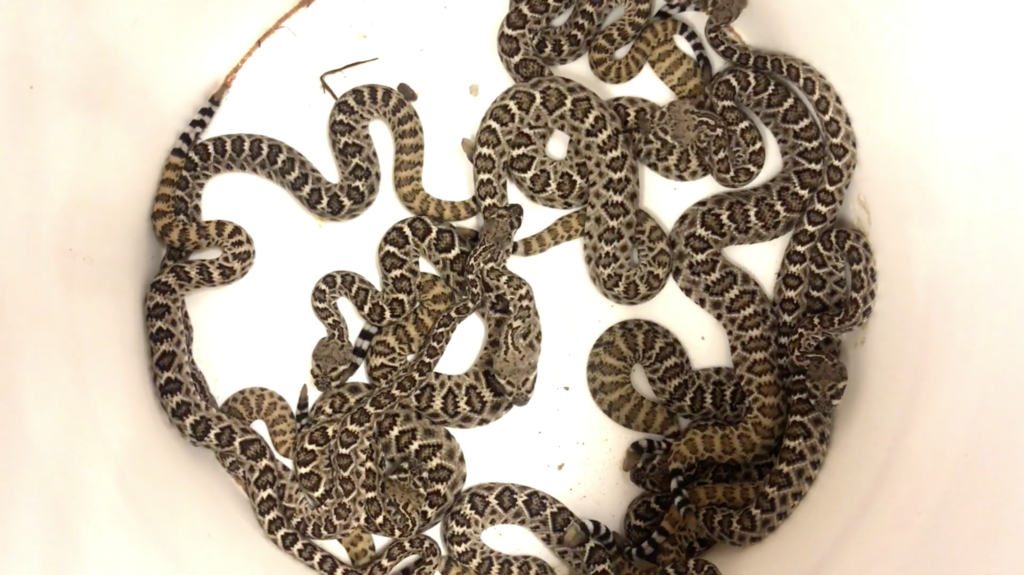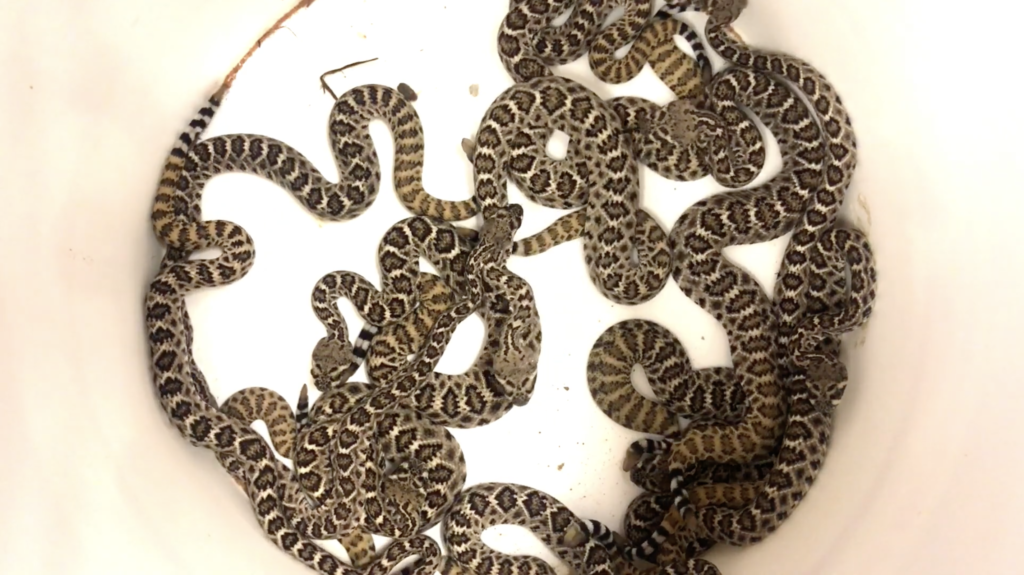Rattlesnakes are fascinating creatures that have captured the interest of many individuals for centuries. One of the most commonly asked questions about these creatures is how big they are when they’re born.
Believe it or not, baby rattlesnakes can be quite small, typically measuring around 8-10 inches in length. However, despite their small size, they still possess the same venomous bite as their adult counterparts, making them just as dangerous. In this article, we’ll explore the fascinating world of baby rattlesnakes and discover just how big they are when they first enter the world.
Rattlesnakes are born relatively large compared to other snake species. On average, newborn rattlesnakes measure around 10-12 inches in length and weigh approximately 1-2 ounces. They are fully equipped with venom and fangs, and can be dangerous to humans despite their small size.

How Big Are Rattlesnakes When Born?
Rattlesnakes are fascinating creatures that belong to the pit viper family. These venomous snakes are known for their distinct rattle on their tail, which they use as a warning sign to potential predators. But have you ever wondered how big these reptiles are when they’re born? Let’s dive into the world of rattlesnakes and find out.
Size at Birth
When rattlesnakes are born, they are relatively small compared to their adult counterparts. The size of a rattlesnake at birth can vary depending on the species, but on average, they are about 10-12 inches long and weigh around 0.5 ounces. This may seem small, but it’s important to note that rattlesnakes grow quickly, and within a few months, they will have doubled in size.
The size at birth also varies depending on the species of rattlesnake. For example, the Eastern diamondback rattlesnake is the largest venomous snake in North America and can give birth to babies that are up to 18 inches long. On the other hand, the pygmy rattlesnake has babies that are only around 5 inches long.
Factors Affecting Size
Several factors can affect the size of a rattlesnake at birth. One of the most significant factors is the size of the mother. Larger mothers tend to give birth to larger babies, while smaller mothers give birth to smaller babies. This is because larger mothers can provide more nourishment to their offspring during pregnancy.
Another factor that affects the size of baby rattlesnakes is the number of babies in the litter. Rattlesnakes can give birth to anywhere from 1 to 25 babies in a single litter. If there are more babies, they will tend to be smaller in size because they have to share the available nutrients.
Benefits of Small Size
Although baby rattlesnakes are small, they are still equipped with venomous fangs and can be dangerous to humans and animals. However, their small size does have some benefits. Baby rattlesnakes are more agile and can move around more easily than their adult counterparts. This allows them to hunt for smaller prey and avoid potential predators.
Another benefit of being small is that baby rattlesnakes are less likely to be detected by predators. They can hide in small crevices and blend in with their surroundings, making them less vulnerable to attack.
Size Comparison: Baby vs. Adult
As mentioned earlier, baby rattlesnakes grow quickly. In just a few months, they can double in size and become much more formidable. On average, adult rattlesnakes can range anywhere from 3-7 feet long and weigh up to 15 pounds, depending on the species.
When comparing baby and adult rattlesnakes, it’s essential to note that the venom of baby rattlesnakes can sometimes be more potent than that of adults. This is because baby rattlesnakes have not yet learned to control the amount of venom they inject, so they tend to release more.
Conclusion
In conclusion, baby rattlesnakes are relatively small when they are born, but they grow quickly and can become quite large within a few months. The size of a baby rattlesnake depends on several factors, including the size of the mother and the number of babies in the litter. Although baby rattlesnakes are small, they are still venomous and can be dangerous. However, their small size does provide some benefits, such as increased agility and the ability to hide from predators.
Frequently Asked Questions
Here are some common questions people ask about rattlesnakes:
What is the size of a newborn rattlesnake?
A newborn rattlesnake is generally around 6-10 inches in length. When they hatch, they are fully equipped with venom and fangs, making them dangerous from birth. Although they are small, they are still capable of delivering a painful and potentially lethal bite.
As they grow, rattlesnakes can reach lengths of up to 8 feet, depending on the species. Their growth rate varies based on factors such as climate, food availability, and genetics.
How do newborn rattlesnakes survive in the wild?
Newborn rattlesnakes are born with all the necessary tools for survival. They have venom and fangs to defend themselves and capture prey, and they are able to hunt small animals such as lizards and mice. However, they are also vulnerable to predators, including birds, mammals, and other snakes.
As they grow, rattlesnakes become more skilled hunters and are better equipped to defend themselves from potential threats. They also develop a rattle on their tail, which they use as a warning signal to scare off predators.
What is the gestation period for a pregnant rattlesnake?
The gestation period for a pregnant rattlesnake varies depending on the species. Generally, it takes around 6-7 months for a rattlesnake to carry its young to term. During this time, the female rattlesnake will seek out a safe and warm place to lay her eggs, which can number anywhere from 1 to 25 or more.
Once the eggs hatch, the baby rattlesnakes are left to fend for themselves and must quickly learn how to survive in the wild.
Are newborn rattlesnakes more venomous than adult rattlesnakes?
Newborn rattlesnakes are just as venomous as adult rattlesnakes. In fact, because they are smaller and their venom glands are not fully developed, they may actually be more dangerous. Their bites can be more potent and are often more difficult to treat.
It’s important to remember that all rattlesnakes, regardless of their age, should be treated with caution and respect. If you encounter a rattlesnake in the wild, it’s best to give it a wide berth and let it go about its business.
Can rattlesnakes be kept as pets?
While some people may find rattlesnakes fascinating and may be tempted to keep them as pets, it is generally not a good idea. Rattlesnakes are wild animals and are not suited for life in captivity. They require specific environmental conditions, such as temperature and humidity, and can become stressed and agitated in captivity.
In addition, keeping a rattlesnake as a pet is illegal in many states. It’s best to appreciate these fascinating creatures from a safe distance and leave them to thrive in their natural habitat.
FEEDING 10 NEWBORN RATTLESNAKE!
In conclusion, the size of a newborn rattlesnake is a fascinating topic that has captured the curiosity of many. While the size of these venomous creatures varies depending on the species and location, the general consensus is that they are quite small.
Despite their small size, newborn rattlesnakes are equipped with the same deadly venom and survival instincts as their larger counterparts. They may be tiny, but they are still a force to be reckoned with.
As our understanding of these fascinating creatures continues to evolve, it is clear that there is still much to be learned about the size and behavior of newborn rattlesnakes. One thing is for sure, however; their small size should not be underestimated.


